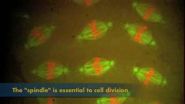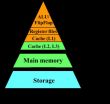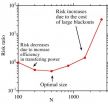(Press-News.org) April 8, 2014 CHAPEL HILL, N.C. – Researchers at UNC School of Medicine have pinpointed a viral protein that plays a major role in making respiratory syncytial virus (RSV) the most common cause of hospitalization in children under one year of age.
The discovery, published April 8 in the Journal of Clinical Investigation, is the first step toward identifying better diagnostics and potential treatments for an infection that strikes nearly all children before they reach the age of three and causing severe disease in 3 percent of infected children. RSV infection leads to the hospitalization of between 75,000 and 125,000 babies under one year of age in the United States every year; globally, RSV is the second-leading cause of infant mortality due to infectious disease behind only malaria.
"We've known for a long time that RSV has an increased propensity, compared to other respiratory viruses, for causing obstruction and inflammation in the narrowest airways of the infant lung, leading to severe bronchiolitis," said Raymond Pickles, PhD, associate professor of microbiology and immunology and senior author of the JCI paper. "But what we've now shown is that RSV has an increased ability to cause airway obstruction because, during an RSV infection, the virus expresses a specific RSV-encoded non-structural protein, or NS2, in epithelial cells, causing the cells to shed from the airway lining and into the airway lumen. This leads to obstruction of airflow in the small airways and overwhelming inflammation."
According to this study, it's this NS2 protein and its effect on epithelial-cell shedding that makes RSV by far the most common cause of bronchiolitis in otherwise healthy young children. The finding was years in the making.
"It was a real struggle to put our finger on differences between RSV and other common respiratory viruses that might account for the increased disease caused by RSV," Pickles said. "We compared the ability of RSV and parainfluenza virus (PIV3) – another common virus in children that causes much less severe airway disease – to infect and cause inflammatory responses in a cell culture model of human epithelial cells, which compose the lining of the lung airway. But comparing these consequences of infection did not provide hints as to why RSV and PIV3 produced such differences in disease severity. We did notice, though, that the epithelial cells infected by RSV looked very different during infection compared to those infected by PIV3."
While the PIV-infected epithelial cells retained their natural elongated, columnar shape, the same cells infected with RSV balled up and puffed out of the airway epithelium, causing the infected cells to accumulate in the lumen of the airway. "We hypothesized that since RSV and PIV3 are very similar viruses these different effects must be due to differences in the types of genes that RSV expresses," Pickles said.
There aren't many genes in RSV, and by generating mutant viruses in the laboratory, Pickles' team found that a specific RSV gene – the NS2 gene – was responsible for the balling up of RSV-infected airway cells. In experiments led by UNC graduate student Rachael Liesman, the researchers decided to engineer PIV3 to express the RSV NS2 gene. When Liesman infected human airway cells in the lab with this re-engineered virus, she saw infected cells ball up and puff out of the airway epithelium. "The cells infected by PIV3 expressing the NS2 gene of RSV looked exactly like RSV-infected cells," Liesman said.
Pickles and Liesman then used their reengineered PIV expressing RSV NS2 in animal models to provide more clinical relevance for their findings. They found that infection of the narrowest airways of the lung by PIV3 alone caused moderate levels of inflammation, but after infection by PIV3 expressing RSV NS2, the epithelial cells lining the narrow airways were shed rapidly into the airway lumen. The shedding occurred at such a great rate that the shed cells obstructed the airway lumen, resulting and caused excessive inflammation.
Pickles said that these findings in animal models were almost identical to what has been found in human infants who had died because of RSV infection. Pickles said, "I'm convinced that the RSV NS2 gene is a major driver for the well-recognized increased ability of RSV to cause lung disease, especially in the extremely narrow small airways of human infants."
Pickles is now on the trail of a human biomarker that would tell doctors if an RSV-infected infant is at greater risk of developing severe lung disease. A biomarker would be key in the development of a needed diagnostic tool and would aid clinical trials that aim to develop anti-RSV therapeutics.
Michelle Hernandez, MD, a pediatric immunologist at UNC, said, "When young children arrive at the hospital with an RSV infection, it's challenging and frustrating to guess which children you can safely send home, versus those you should admit to the hospital because they might require supportive care in an intensive care unit. Any information that will help us make these decisions not only helps us ensure that we provide the best care for these kids, but also helps us use health care resources more wisely."
Using animal models, Pickles has already found candidate molecular biomarkers that indicate if the epithelial cells in the tiniest airways are expressing the RSV NS2 protein. He is now initiating studies to look for the same biomarkers in human infants infected with RSV.
"If we can find biomarkers informing us that the most vulnerable parts of the lung have already been infected by RSV, then it could be possible to identify much more quickly the children at more risk for developing severe lung disease and to get those babies in a treatment protocol at an earlier time," Pickles said.
Regarding whether these findings could lead to better RSV treatments, Pickles said it may be possible to suppress the ability of NS2 to shed the airway epithelial cells. Thwarting this shedding effect wouldn't stop infection or stifle the typical symptoms of RSV infection, but it might limit the virus's ability to spread into the tiniest airways, which are the most likely to be obstructed by cells shed during infection. This would lead to a less severe infection and fewer hospitalizations.
Pickles added that suppressing the effects of the RSV NS2 protein may also allow our immune system more time to deal with the RSV infection before the small airways become clogged with cells shedding from the lining of the airway. He said, "These are questions we are aiming to answer in studies already underway."
INFORMATION:
Raymond Pickles, PhD, is a member of the UNC Cystic Fibrosis and Pulmonary Research and Treatment Center. Rachael Liesman, PhD, is now a postdoctoral fellow in the Pickles lab. Other authors of the JCI paper include Ursula Buchholz, PhD, and Peter Collins, PhD at the NIH; Alan Proia, MD, PhD, at Duke University; and John DeVincenzo, MD, at the University of Tennessee.
Funding for this research was provided by grant awards from the NIH, the UNC University Research Council, and the Howard Hughes Medical Institute Med-Into-Grad Scholar Initiative (Liesman).
UNC researchers find genetic trigger for RSV-induced infant hospitalizations
The discovery could lead to new therapies and better diagnostics, resulting in fewer hospitalizations of children with respiratory syncytial virus, the leading cause of severe lung infection in babies
2014-04-08
ELSE PRESS RELEASES FROM THIS DATE:
The double whammy of multiple sex partners and drinking in HIV/STI prevention
2014-04-08
PHILADELPHIA (April 8, 2014) – The cartoon character Homer J. Simpson once said "Alcohol: The source of, and solution to, all of life's problems."
The sage of the ubiquitous and fictional town of Springfield may have hit the nail on the head when it comes to human immunodeficiency virus (HIV) and sexually transmitted infections (STIs) counseling and prevention. The more you drink and/or the more sex partners you have, the less likely you are to engage in HIV-prevention programs.
This rather grim assessment came about from the study, "Barriers to accessing HIV-prevention ...
Language structure… you're born with it
2014-04-08
Humans are unique in their ability to acquire language. But how? A new study published in the Proceeding of the National Academy of Sciences shows that we are in fact born with the basic fundamental knowledge of language, thus shedding light on the age-old linguistic "nature vs. nurture" debate.
THE STUDY
While languages differ from each other in many ways, certain aspects appear to be shared across languages. These aspects might stem from linguistic principles that are active in all human brains. A natural question then arises: are infants born with knowledge of how ...
Advanced warning systems increase safety at intersections, study shows
2014-04-08
Most drivers have experienced a traffic signal that turns yellow just as they approach an intersection, which makes it difficult for them to decide whether to stop or proceed through it. The wrong choice in this situation, known as the "dilemma zone," may lead to crashes, especially at high-speed intersections.
A major factor making driving difficult is hazards that are sudden and hard to predict. Roadside and in-vehicle display warning systems may help drivers handle these hazards by predicting their occurrence and providing advanced warning to the driver, according ...
Lipid levels during prenatal brain development impact autism: York U study
2014-04-08
In a groundbreaking York University study, researchers have found that abnormal levels of lipid molecules in the brain can affect the interaction between two key neural pathways in early prenatal brain development, which can trigger autism. And, environmental causes such as exposure to chemicals in some cosmetics and common over-the-counter medication can affect the levels of these lipids, according to the researchers.
"We have found that the abnormal level of a lipid molecule called Prostaglandin E2 in the brain can affect the function of Wnt proteins. It is important ...
Kinesin-5 structure opens cancer drug targets
2014-04-08
VIDEO:
Kinesin-5 plays a crucial role in cell division by allow microfilaments to slide past each other. The kinesin-5 structure shows a central rod connecting two motor units that walk along...
Click here for more information.
The structure of a key part of the machinery that allows cells to divide has been identified by researchers at the University of California, Davis -- opening new possibilities for throwing a wrench in the machine and blocking runaway cell division in cancer.
"The ...
Phase II trial of efatutazone shows challenge of matching treatment to population
2014-04-08
Work at the University of Colorado Cancer Center led to phase II trial of efatutazone with erlotinib in patients with refractory non-small cell lung cancer. Results are reported today at the American Association for Cancer Research (AACR) Annual Meeting 2014. While efatutazone did not improve the efficacy of erlotinib in this trial, researchers hope lessons from the trial will allow them to make better future use of the drug or other drugs in its class.
"In oncology and especially in lung cancer, everything is personalized. We're exploring different molecular markers ...
Glucosamine promotes longevity by mimicking a low-carb diet
2014-04-08
Glucosamine has been freely available in drugstores for many decades. It is widely used to treat arthritis and to prevent joint degeneration. Moreover, glucosamine is known to delay cancer growth. In addition, glucosamine reduces metabolism of nutritive sugars, as was already shown some 50 years ago.
In 2007, Michael Ristow showed that too much nutritive sugar shortens the lifespan of roundworms, a widely studied model organism in ageing research. Conversely, impairing carbohydrate metabolism in these worms was capable of extending lifespan [reference 1]. Unfortunately, ...
Future computers that are 'normally off'
2014-04-08
WASHINGTON D.C., April 8, 2014 -- If a research team in Japan gets its wish, "normally off" computers may one day soon be replacing present computers in a move that would both eliminate volatile memory, which requires power to maintain stored data, and reduce the gigantic energy losses associated with it.
Most parts of present computers are made with volatile devices such as transistors and dynamic random access memory (DRAM), which loses information when powered off. So computers are designed on the premise that power is "normally on."
Back in 2000, the concept of ...
Is the power grid too big?
2014-04-08
WASHINGTON D.C., April 8, 2014 -- Some 90 years ago, British polymath J.B.S. Haldane proposed that for every animal there is an optimal size -- one which allows it to make best use of its environment and the physical laws that govern its activities, whether hiding, hunting, hoofing or hibernating. Today, three researchers are asking whether there is a "right" size for another type of huge beast: the U.S. power grid.
David Newman, a physicist at the University of Alaska, believes that smaller grids would reduce the likelihood of severe outages, such as the 2003 Northeast ...
Rice U. study: Creativity and innovation need to talk more
2014-04-08
HOUSTON – (April 8, 2014) – Creativity and innovation are not sufficiently integrated in either the business world or academic research, according to a new study by Rice University, the University of Edinburgh and Brunel University.
The findings are the result of the authors' review of the rapidly growing body of research into creativity and innovation in the workplace, with particular attention to the period from 2002 to 2013.
"There are many of us who study employee creativity and many of us who study innovation and idea implementation, but we don't talk to each ...
LAST 30 PRESS RELEASES:
Boosting the cell’s own cleanup
Movement matters: Light activity led to better survival in diabetes, heart, kidney disease
Method developed to identify best treatment combinations for glioblastoma based on unique cellular targets
Self-guided behavioral app helps children with epilepsy sleep earlier
Higher consumption of food preservatives is associated with an increased risk of type 2 diabetes
NTU Singapore-led team captures first-ever ‘twitch’ of the eye’s night-vision cells as they detect light, paving the way for earlier detection of blindness-causing diseases
Global aviation emissions could be halved through maximising efficiency gains, new study shows
Fewer layovers, better-connected airports, more firm growth
Exposure to natural light improves metabolic health
As we age, immune cells protect the spinal cord
New expert guidance urges caution before surgery for patients with treatment-resistant constipation
Solar hydrogen can now be produced efficiently without the scarce metal platinum
Sleeping in on weekends may help boost teens’ mental health
Study: Teens use cellphones for an hour a day at school
After more than two years of war, Palestinian children are hungry, denied education and “like the living dead”
The untold story of life with Prader-Willi syndrome - according to the siblings who live it
How the parasite that ‘gave up sex’ found more hosts – and why its victory won’t last
When is it time to jump? The boiling frog problem of AI use in physics education
Twitter data reveals partisan divide in understanding why pollen season's getting worse
AI is quick but risky for updating old software
Revolutionizing biosecurity: new multi-omics framework to transform invasive species management
From ancient herb to modern medicine: new review unveils the multi-targeted healing potential of Borago officinalis
Building a global scientific community: Biological Diversity Journal announces dual recruitment of Editorial Board and Youth Editorial Board members
Microbes that break down antibiotics help protect ecosystems under drug pollution
Smart biochar that remembers pollutants offers a new way to clean water and recycle biomass
Rice genes matter more than domestication in shaping plant microbiomes
Ticking time bomb: Some farmers report as many as 70 tick encounters over a 6-month period
Turning garden and crop waste into plastics
Scientists discover ‘platypus galaxies’ in the early universe
Seeing thyroid cancer in a new light: when AI meets label-free imaging in the operating room
[Press-News.org] UNC researchers find genetic trigger for RSV-induced infant hospitalizationsThe discovery could lead to new therapies and better diagnostics, resulting in fewer hospitalizations of children with respiratory syncytial virus, the leading cause of severe lung infection in babies




